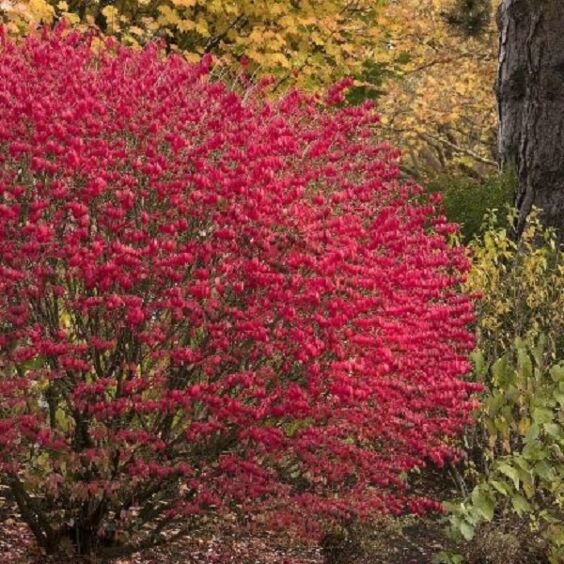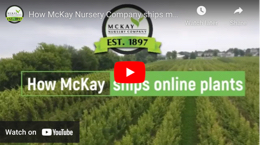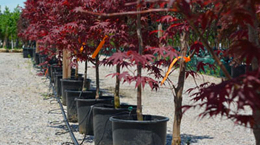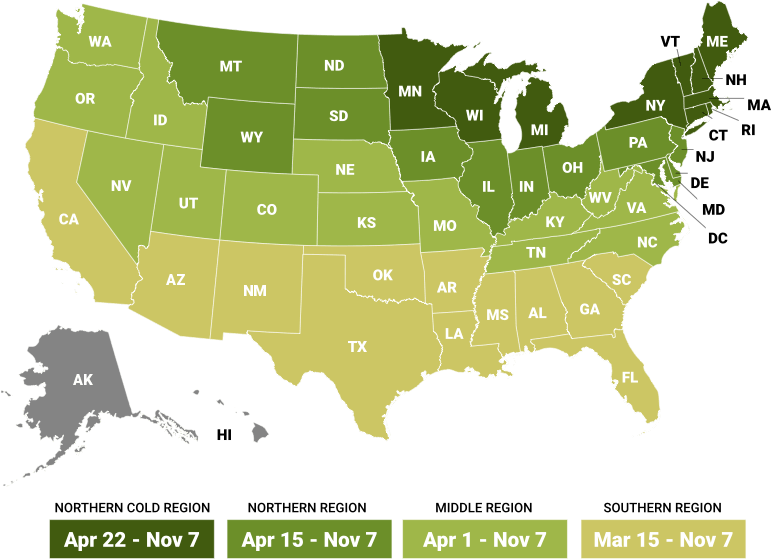
Growing zones
See Zone Map >Status: In stock
The Dwarf Burning Bush is celebrated not only for its fiery autumnal hues but also for its lush, dark green leaves throughout the spring and summer, providing a stark contrast and visual interest throughout the year. Ideal for creating eye-catching hedges or as a standalone specimen, this shrub maintains a compact form with minimal effort. An annual pruning is all it takes to preserve its neat, rounded shape, making it a low-maintenance choice for gardeners seeking maximum impact with minimal care.
No sizes are available to ship to Maryland, Maine, Minnesota, New Hampshire, New York, or Vermont.
Please note: #5 containers cannot be shipped to Maine, Maryland, Minnesota, New Hampshire, New York, Vermont, Arizona, California, Idaho, Montana, Nevada, Oregon, Utah, Washington due to size restrictions.
- Sun, Part Sun/Shade, Shade
Mature Plant Size (H x W): 5-6' x 5-6'
Bloom Season: Spring
- Walnut Toxicity Resistant
- Hedges & Screens
Planting & Care for Deciduous Shrub – Euonymus ‘Compactus’
Preparation
- This plant is easily grown in average, medium moisture, well-drained soil in full sun to part shade.
- Tolerates close to full shade, but this will diminish the quality of the vibrant red fall color.
- This is an adaptable shrub that tolerates a wide range of soils except for wet, poorly-drained ones.
- Compactus' is a popular burning bush cultivar. It is a deciduous shrub which is not all that "compact" since it typically grows in a mound to 10' tall with a slightly larger spread, though it can easily be kept shorter by pruning.
- Use this bright red shrub as a specimen, mass planting in foundations, shrub borders, screens or hedges.
- If you are trimming burning bushes to rejuvenate them, you should do this in early spring, before the burning bush puts out leaves.
- If you are pruning a burning bush to shape it, you can prune it while it is dormant, in late winter or early spring.
Opening Plant Material
- Bare Root - Cut open the bundle (top and roots are tied) and separate all the plants. Soak roots in buckets of water until planted. Each plant type will be labeled separately for identification. Do not expose the roots to the sun. They should never dry out. Keep roots covered. All bare-root plants must be trimmed when planted.
- B&B - Soak root ball very well. Dig a hole at least 6" wider and no deeper than the size of the ball on the plant. Rotate the plant to the proper position. Never lift or move trees by the tops.
- Containers - Water your potted plants thoroughly by placing them in a bigger container filled with water. Wait until you see no more bubbles, then take them out. They're now ready to be planted. When you dig a hole for planting, make sure it's as deep as the pot but at least 6 inches wider around the sides.
Planting Bare Root
- Plant bare roots in fall. A reliable indicator that you can still plant is if the ground remains workable; if so, you're good to go. If a hard frost is expected, be sure to hold off on planting.
- Dig a hole at least 6" wider and the same depth as the root mass. The crown or graft of the plant should be slightly higher than ground level where it was grown at the nursery.
- Trim off the broken roots and branches.
- Place fertilizer packets in hole (if purchased). Do not place other fertilizers in the planting hole. *Use Our Recommended Fertilizer.
- Spread the roots and fill halfway with soil, then water until the soil settles completely, saturating the soil and planting pit.
- Re-adjust the plant and fill the hole with the rest of the soil.
- Back fill the balance of the soil and water well.
- Download our “Handling & Planting Guidelines” below for illustrations on planting.
Planting B&B Trees
- Plant B&B trees in spring or fall. A reliable indicator that you can still plant is if the ground remains workable; if so, you're good to go. If a hard frost is expected, be sure to hold off on planting.
- Notice where the base of the trunk flairs out from the tree. This is called the root flair. This root flair should show when the tree is planted. If necessary, add soil under the ball so the root flair is exposed.
- Place fertilizer packets into the bottom of the hole (if purchased). *Use Our Recommended Fertilizer
- Backfill ½ of the hole with soil and completely saturate the soil with water.
- Cut and remove twine once the tree is straight and located as desired. Then, remove or bend back the top of the metal basket. Lastly, remove the exposed burlap from the top of the ball.
- Fill the hole to the top of the ball with soil, then soak well with water and let settle.
- The top of the root ball should be visible and slightly higher than the soil around it.
- Add mulch on top of the soil, making sure not to put mulch against the trunk or stems.
Planting Containers
- Slide the plant from the pot by tapping on the bottom of the pot.
- With a shovel or knife, trim the bottom 2" off the root ball for plants in plastic containers.
- Rotate the plant to the proper position. Never lift or move plants by the tops.
- Place the root ball in the hole.
- Notice where the base of the trunk flairs out from the tree. This is called the root flair. This root flair should show when the tree is planted. If necessary, add soil under the ball so the root flair is exposed.
- Place fertilizer packets into the bottom of the hole (if purchased). *Use Our Recommended Fertilizer.
- Backfill the hole with soil, making sure the top of the root ball is visible and slightly higher than the soil around it.
- Firm the soil around the plant. Water well to settle the soil around the root ball.
Pruning - After Planting
- Bare Root - Prune ALL bare root plants to reduce transplant shock and ensure success. Pruning should take place either before planting or as soon as possible afterward. All pruning should be done with sharp pruning shears.
- B&B & containers - While it is not crucial for balled and burlapped (B&B), grow bags, or container plants to be pruned immediately after planting, a light pruning to shape, remove any broken branches damaged during shipping, or thin out a densely branched plant can aid in the transplanting process and improve the appearance of your new planting.
Pruning - Throughout the Season
- If you are trimming burning bushes to rejuvenate them, you should do this in early spring, before the burning bush puts out leaves.
- If you are pruning a burning bush to shape it, you can prune it while it is dormant, in late winter or very early spring.
Watering - After Planting
- Plants typically take approximately 6 weeks to establish new roots in your soil. During this period, water plants as often as every 2-4 days at the start and at least a minimum of once per week.
- Beyond the 6 week establishment period, water once per week, unless rains occur.
- Stick your finger 3” into the soil to check soil moisture.
Watering - Throughout the Season
- After the first season, plants should only be watered during extended periods without rain.
- The easiest way to tell if your plants need water is to touch the soil around the roots. If it is moist, there is no need to water. If it is dry, give it a good soaking with the hose end (no nozzle), watering the soil only, not the leaves.
- Stick your finger 3” into the soil to check soil moisture.
Frequently Asked Questions
Discover helpful gardening tips and insights in our FAQs, featuring McKay Nursery's Dwarf Burning Bush.
1. How much sun does the Dwarf Burning Bush need to thrive?
The Dwarf Burning Bush requires full sun to partial shade to thrive. For the most brilliant red fall foliage, plant it in a location that receives at least 6 hours of direct sunlight a day.
Ensure it receives adequate water throughout the growing season. While the bush is relatively low-maintenance, an annual pruning to remove dead or overcrowded branches can also help maintain the bright red color in the fall by improving air circulation and light penetration throughout the plant.
2. Is the Dwarf Burning Bush suitable for small gardens?
Yes, the Dwarf Burning Bush is particularly well-suited for small to midsize gardens. It grows into a neatly rounded shrub, making it an excellent choice for those looking to add a splash of color without overwhelming their space.
3. How often should I water the Dwarf Burning Bush?
Water the Dwarf Burning Bush regularly during its first growing season to establish a deep, extensive root system. Once established, it's relatively drought-tolerant but benefits from occasional watering during prolonged dry spells, especially in very hot or windy conditions.
4. Can the Dwarf Burning Bush be used as a hedge?
Absolutely. The Dwarf Burning Bush is an excellent choice for hedges due to its dense growth habit and ease of pruning. It can be trimmed once a year to maintain the desired shape and size, making it a versatile and attractive option for defining boundaries or creating privacy screens.
Enhance Your Landscape with McKay Nursery
Leveraging over a hundred years of horticultural expertise, McKay Nursery is proud to offer the Dwarf Burning Bush, a standout choice for adding vibrant color to your garden. When you purchase from us, you receive a plant of unmatched quality, backed by our comprehensive warranty. Our meticulous packaging ensures your Dwarf Burning Bush arrives in excellent condition, ready to make a striking impact in its new home. For guidance or further information, reach out to us at [email protected] or call 920-478-2121.
Planting & Handling Help
Download our Planting and Handling Guide below to plan for a successful arrival and install of your plants. Be sure to water all plants as soon as they arrive and every day until you’re ready to plant. Keep any bare root bundles in a shady, cool spot with the roots covered at all times.


Learn More
Watch our videos on handling bare root plants, how your order is prepared for shipment and more.


Plant Sizing
What is the difference between Containers, Grow Bags, Bare Root, and Balled & Burlap (B&B)?
Shipping Times


Our FedEx and local shipping times depend on two factors, one is by the region and the second is the type of product being shipped. For example, small fruits are only shipped in spring, but majority of our perennials are shipped from spring until fall. Keep in mind the dates below act as a general guide. Due to unpredictable weather, staffing, inventory and industry demands these timelines can change. Therefore, we cannot guarantee any of these times.
Shipping Dates by Region*
Northern Cold Region: April 22nd - November 7th
Northern Region: April 15th - November 7th
Middle Region: April 1st - November 7th
Southern Region: March 15th - November 7th
Local Delivery (small radius from Waterloo, WI): April 22nd - November 7th
Shipping Dates by Season*
Spring Shipping: Region Start Date (above) - May
Fall Shipping: September - November
Due to unpredictable weather, these times may vary. Some varieties are exceptions due to heat and plant health reasons. Enter your shipping zip code at the top of this page and be sure to check the shipping information on each product before you add it to your cart. If the product is too large or restricted in your state, you will not be able to checkout with that item in your cart.
